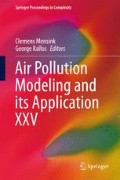Abstract
This study is based on AOD values from long-term re-analysis of atmospheric composition and air quality performed with SILAM model in Finnish Meteorological Institute. This study uses two spatial scales: global (1.44° Resolution, ERA-Interim re-analysis meteo data) and Northern Europe (0.1°, BaltAn65+ meteo). The emission information is compiled from the MACCITY and EDGAR anthropogenic, GEIA lightning and aircraft, MACCity-ACCMIP biomass-burning, and MEGAN biogenic emission inventories. The emission of sea salt and wind-blown dust is computed with embedded SILAM modules. Comparison of AOD from global run for 2008–2014 with 13 Aeronet stations in the Baltic Sea region (54 to 63° N and 8 to 38° E) show underestimation of station-wise average AOD-s by factor of 1.5–2.6, whereas the predicted and measured values are well correlated: linear correlation coefficients based on hourly values in different stations range from 0.46 to 0.85 (average 0.59). Nordic run made for only year 2010 show underestimation by factor of 1.6–4.1 with linear coefficients ranging from 0.33 to 0.73. Thus, the underestimation was a bit lower in the global run. A reason of underestimation may be missing local ground dust emissions and long-term realistic fire emissions that are only available until 2008 Granier et al. (Clim Change 109:163, 2011). Also, AOD measurements made with sun photometer like it is done in Aeronet stations tend to give higher AOD values than actinometric measurements do. The analysis based on longer time series (since 1990) is in progress.
Access this chapter
Tax calculation will be finalised at checkout
Purchases are for personal use only
References
Granier C, Bessagnet B, Bond T et al (2011) Clim Change 109:163. doi:10.1007/s10584-011-0154-1
Kannel M, Ohvril H, Okulov O (2012) A shortcut from broadband to spectral aerosol optical depth. Proc Est Acad Sci 61(4):266–278
Sofiev M, Kouznetsov R, Prank M, Soares J, Vira J, Tarvainen V (2017) A long-term re-analysis of atmospheric composition and air quality (in this volume)
Acknowledgements
This study was funded by Estonian Research Council research projects PUT645 and IUT20-11.
Author information
Authors and Affiliations
Corresponding author
Editor information
Editors and Affiliations
Questions and Answers
Questions and Answers
Questioner: Ulas Im
Question: Have you done any comparison with satellite observations?
Answer: No, only with ground measurements.
Questioner: V. Matthias
Question: Could you explain how the AOD is calculated in the model? In particular, do you take aerosol growth with humidity into account?
Answer: Yes
Questioner: Paul Makar
Question: Is SILAM an online or offline model? If offline—the AQMEII-2 special issue in Atmospheric Environment has several papers examining the Russian fires of 2010. These online model papers showed that the cloud of particles from the fires reduced downward shortwave radiation flux by 80 W/m2. This resulted in reduced PBL heights and higher concentrations. Part of the AOD underestimation you have might be due to the PBL height too high, hence not as much horizontal dispersion due to lower wind speeds, hence higher AOD values than simulated by SILAM. You could try comparing SILAM’s PBL heights to those simulated in the AQMEII-2 papers to check this.
Answer: SILAM is an offline model. There is a paper in Atmospheric Environment about SILAM as well: Toll, V.; Reis, K.; Ots, R.; Kaasik, M.; Männik, A.; Prank, M.; Sofiev, M. (2015). SILAM and MACC reanalysis aerosol data used for simulating the aerosol direct radiative effect with the NWP model HARMONIE for summer 2010 wildfire case in Russia. Atmospheric Environment, 121, 75–85, j.atmosenv.2015.06.007.
Rights and permissions
Copyright information
© 2018 Springer International Publishing AG
About this paper
Cite this paper
Reis, K., Sofiev, M., Prank, M., Jakobson, E., Kaasik, M. (2018). Climatological Modelled and Measured AOD in Baltic Sea Region. In: Mensink, C., Kallos, G. (eds) Air Pollution Modeling and its Application XXV. ITM 2016. Springer Proceedings in Complexity. Springer, Cham. https://doi.org/10.1007/978-3-319-57645-9_19
Download citation
DOI: https://doi.org/10.1007/978-3-319-57645-9_19
Published:
Publisher Name: Springer, Cham
Print ISBN: 978-3-319-57644-2
Online ISBN: 978-3-319-57645-9
eBook Packages: Earth and Environmental ScienceEarth and Environmental Science (R0)

